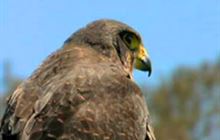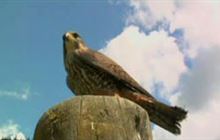New Zealand falcon/kārearea
Introduction
Capable of flying at speeds up to 200 km/h and catching prey larger than itself, the New Zealand falcon is one of our most spectacular birds.New Zealand status: Endemic
Conservation status:
- Southern form is Threatened–Nationally Endangered
- Eastern form is Threatened–Nationally Vulnerable
- Bush form is Threatened–Nationally Increasing
Population: Uncertain but likely between 5,000–8,000
Found in: Most of New Zealand south of Waikato, some offshore islands including Auckland Islands
Threats: Predation, habitat loss, disturbance, development impacts, human persecution, electrocution
Species information: NZ falcon/kārearea on NZ Birds Online
Image gallery
-
NZ falcon at Hutt riverbank Image: Shona Simpson ©
![NZ falcon at Hutt riverbank NZ falcon at Hutt riverbank]()
-
NZ falcon fledgling bred and released to the wild by Marlborough Falcon Trust Image: Marlborough Falcon Trust ©
![Released falcon on log. Released falcon on log.]()
-
Millie the falcon, Wingspan Centre Image: Sabine Bernert ©
![Close up of falcon. Close up of falcon.]()
-
Fern the falcon with Diana at Brancott Estate Image: Brancott Estate ©
![Woman holding falcon. Woman holding falcon.]()
-
Falcon chick with down Image: Andy and Bev Frost, Marlborough Falcon Trust ©
![Falcon chick with down. Falcon chick with down.]()
-
Laurence Barea banding a falcon chick Image: Oliver Overdyck ©
![Chick being banded. Chick being banded.]()
Facts
Distribution and density
One of 38 species of falcon worldwide, the New Zealand falcon is endemic to this country.
The falcon has a wide distribution, being found on both the North and South Islands and several offshore islands, including Stewart Island and the subantarctic Auckland Islands. Recently, plantation pine forests have been found to be important breeding habitats for falcons. The highest known density of the species is found in Kaingaroa pine forest in the central North Island.
Three ecological forms
The small dark ‘Bush’ falcons live in forests. They are found in the North Island, mainly south of Hamilton; and NW South Island as far south as Greymouth.
Large paler 'Eastern' falcons live in open dryer habitats east of the Southern Alps but extend from coast to coast in central South Island.
'Southern' falcons are intermediate in size and colouration and live in Fiordland, Stewart Island and the Auckland Islands.
Adult New Zealand falcons measure between 40 cm and 50 cm. Males are smaller than females. Males weigh between 240 g and 350 g, while females weigh between 410 g and 720 g.
Hunting
The New Zealand falcon is capable of flying at speeds of up to 200 km/h, and can catch prey larger than itself.
They hunt live prey, mainly by watching from a vantage point and making a fast direct flying attack and either striking or grasping the prey with their feet which are equipped with sharp talons. They kill their prey with a quick powerful bite to the neck.
Their diet includes a range of animals, including insects, mammals and lizards, but consists mainly of birds.
Breeding
Like all falcons, the New Zealand falcon does not build a nest. Rather, it makes a scrape on the ground, under a rocky outcrop or in an epiphyte in an emergent forest tree into which it lays its eggs.
A typical clutch consists of 2–4 eggs which take about 33 days to hatch.
Nestlings are fed by both parents but the male does most of the hunting with the female guarding close to the nest until the nestlings are close to fledging, which occurs between 31 and 45 days after hatching.
Sound recording
New Zealand falcon/kārearea juvenile female song (MP3, 721K)
00:45 – Captive juvenile female giving a call apparently used as warning or irritation.
New Zealand falcon/kārearea female song (MP3, 468K)
00:29 – Female giving calls soliciting food from male.
Our bird songs can be reused, even commercially, according to our copyright terms.
Threats
Threats to the New Zealand falcon are not well understood.
All three forms of New Zealand falcon (Southern, Eastern and Bush) are ranked as threatened due to population declines and uncertainty in the overall population sizes.
Predation
Although still widespread where suitable habitat exists, numbers have declined and predation by cats, mustelids, and hedgehogs is emerging as a problem for ground nesting falcons.
It is likely that stoats and other mustelids prey on eggs and nestlings in ground and tree nests, and rats may do the same. A recent study suggests that adult falcons are less able to defend their nest from predators that previously thought. More research is needed in this area.
Video of cat attack on falcon chicks
The video shows a wild cat entering a New Zealand falcon nest. It attacks one of two chicks. The other chick stays in the nest while this is happening. The mother twice tries to drive off the cat but is unsuccessful.
This shows that falcons are not necessarily able to successfully defend the nest (at least against cats which are thought to be important predators) despite being capable predators themselves. The cat spent 10 hours in the nest and killed both chicks.
There is no sound on the video.
- Play video in Windows Media Player (WMV, 697K, 29 seconds)
- Play video in QuickTime (MOV, 2563K, 29 seconds)
Loss of habitat
Forest dwelling falcons often nest in emergent rimu and other large forest trees. Continued selective logging of such trees reduced available nesting habitat.
Tussock grassland and grey scrub habitats being converted to pasture also reduces nesting and prey habitat.
Human impact
Like many birds of prey overseas, New Zealand falcons are also threatened by electrocution on power poles containing transformers.
Despite their fully protected status, New Zealand falcons are still illegally shot by people, particularly when falcons occasionally kill racing pigeons or chickens.
Recently a new threat to New Zealand falcons has emerged in the form of wind farms. High mortality rates have been reported for some birds of prey at several overseas wind farms due to collision with the rotating turbine blades. The construction of wind farms in New Zealand falcon habitat may expose it to similar risks.
DOC's work
New Zealand falcons likely benefit from the predator control done by DOC around the country.
DOC advocates for New Zealand falcon conservation through the Resource Management Act (RMA) process, in particular in the context of wind farm development.
DOC has supported a genetic analysis to better understand any differences between Bush, Eastern and Southern falcons.
The use of falconry techniques by qualified experts is recognised by DOC as an important tool in conditioning injured or orphaned falcons for release.
Conceptual support, facilitation and permits are provided for external initiatives such as the Marlborough Falcon Conservation Trust project, release of captive bred falcons by Wingspan Birds of Prey Trust and university research.
You can help
Support a falcon conservation organisation
Wingspan Birds of Prey Trust
Cares for sick, injured and orphaned raptors. This includes research, captive breeding, public awareness work and rehabilitating raptors back into the wild.
Kārearea Falcon Trust
Cares for and rehabilitates injured New Zealand falcons. Conserves species through captive breeding and release, education and advocacy.
Learn more about kārearea at NZ Birds Online.
Don't shoot
Don’t shoot falcons! If you are experiencing problems call your local DOC office.
Help keep their nests safe
Control predators (cats, hedgehogs, stoats, weasels, ferrets and rats) on your property if it has falcon nesting habitats. Eggs and nestlings are more likely to survive, and there will be more food available.
Keep away from their nests. Falcons defend their nests actively and may dive bomb people up to 400 m from the nest. If this happens, move away until the attack stops. Don’t try to strike a falcon as you are likely to injure it and place the falcon chicks in danger.
Emergency hotline
Call 0800 DOC HOT (0800 362 468) immediately if you see anyone catching, harming or killing native wildlife.
On your property
- Trap predators on your property.
- Be a responsible cat owner.
In your community
- Find and volunteer with your local community group
- Trap predators in your community
- Get kids or schools involved
See Predator Free 2050 Trust - get involved for information.
Visiting parks, beaches, rivers, and lakes
- Leave nesting birds alone.
- Use available access ways to get to the beach.
- Avoid leaving old fishing lines in the water.
- Follow the water care code and local navigation bylaws.
- Do not drive on riverbeds, or keep to formed tracks if you have to.
- Check for pests if visiting pest-free islands.
With your dog
- Only take dogs to areas that allow them, and keep them under control.
- If you come across wildlife put your dog on a lead and lead it away.
- Warn other dog owners at the location.
- Notify DOC if you see wildlife being harassed by people or dogs.
- Get your dog trained in avian awareness.
- Learn about the Lead the Way programme which encourages dog owners to become wildlife wise and know how to act to protect coastal wildlife.
Specific ways to keep wildlife safe while with your dog on beaches.








